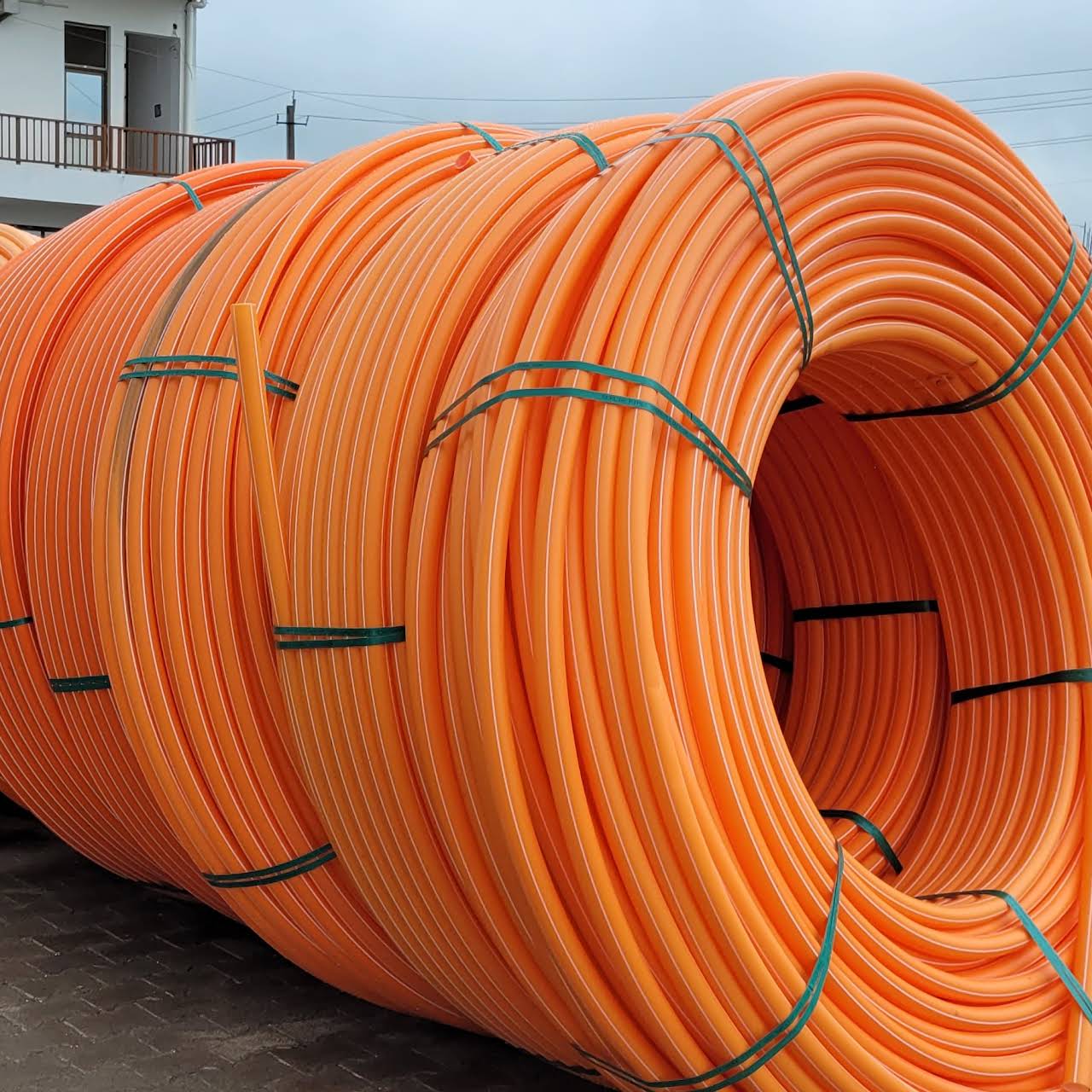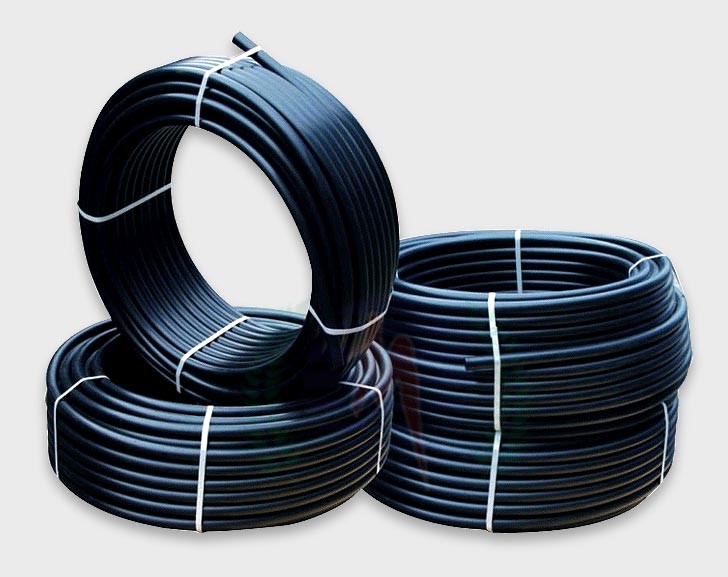Explore the Production Refine Behind High-Quality HDPE Pipe and Its Applications
The manufacturing procedure of high-grade HDPE pipelines is complex and systematic. It begins with the selection of raw products that enhance performance. Following this, ethylene undergoes polymerization to develop material, which is then shaped through extrusion. Quality control is paramount, making certain that the final product satisfies stringent requirements. However, the trip of HDPE pipes does not end with manufacturing. Their applications throughout numerous industries expose a more comprehensive relevance worth taking a look at.
Recognizing HDPE: Properties and Advantages

High-density polyethylene (HDPE) is a flexible polycarbonate recognized for its toughness and resistance to different ecological variables. This product exhibits outstanding tensile strength, making it ideal for demanding applications. Its low-density framework adds to a light-weight item, helping with ease of managing and setup. HDPE likewise showcases exceptional resistance to chemicals, which minimizes deterioration when subjected to severe compounds.
The product's low moisture absorption further enhances its longevity, making it optimal for usage in pipes and storage space containers. In addition, HDPE is resistant to ultraviolet (UV) radiation, guaranteeing that items keep their integrity also when revealed to sunshine. Furthermore, its versatility enables for the development of intricate shapes without compromising strength. The environmentally friendly nature of HDPE, usually stemmed from recycled materials, adds to its appeal, promoting sustainable techniques in manufacturing. Generally, these homes and benefits make HDPE a favored selection for numerous industrial and customer applications.
Resources Option for HDPE Manufacturing
The selection of raw products for HDPE production is crucial to confirm the last item meets the preferred specifications and high quality requirements. High-density polyethylene (HDPE) is primarily created from polymerized ethylene, originated from nonrenewable fuel sources such as gas or petroleum. The quality of these feedstocks greatly affects the mechanical and thermal residential properties of the final HDPE.
Additives likewise play a considerable duty in improving HDPE's efficiency, consisting of antioxidants, UV stabilizers, and colorants, which boost toughness and resistance to environmental aspects. The option process must take into consideration not only the chemical structure of the raw products yet likewise their handling features to assure effective production.
Additionally, the sourcing of resources should prioritize sustainability and compliance with ecological policies, as liable techniques are vital in today's market. Eventually, cautious raw material selection lays the structure for producing premium HDPE pipelines appropriate for varied applications.
The Extrusion Process: Shaping HDPE Pipe
The extrusion procedure plays a vital role in forming HDPE pipes, beginning with careful product prep work strategies that assure perfect flow and uniformity. Just as vital is the layout of the die, which straight influences the final measurements and surface area quality of the pipe. Together, these elements contribute considerably to the effectiveness and high quality of HDPE pipeline manufacturing.
Product Preparation Techniques
Effective manufacturing of HDPE pipes starts with careful material preparation techniques, specifically the extrusion procedure. During this phase, high-density polyethylene material is initial dried out to eliminate moisture, guaranteeing ideal circulation qualities. The resin is then fed into the extruder, where it goes through home heating and melting, transforming right into a thick state. This heating procedure is meticulously controlled to maintain the material's stability and efficiency. The liquified HDPE is compelled via a die, shaping it into a continuous pipeline form. Appropriate temperature level management throughout extrusion is essential, as it directly impacts the material's residential or commercial properties and the last product high quality. When formed, the HDPE pipe is cooled and reduced to defined sizes, ready for subsequent handling and applications.
Die Style Importance
Accuracy in die layout plays an essential function in the extrusion procedure of HDPE pipes. The die acts as the last shaping device, straight influencing the pipeline's measurements, wall density, and surface area finish. A properly designed die assurances consistent material flow, decreasing defects such as irregularities and weak points. The geometry of the die should be optimized to fit the specific homes of HDPE, including its thickness and thermal behavior during extrusion. Furthermore, the cooling price of the material as it passes with the die can substantially affect the pipeline's architectural integrity. Spending in sophisticated die modern technology is vital for manufacturers aiming to create premium HDPE pipelines that fulfill market standards and customer expectations.
Quality Assurance Procedures in HDPE Manufacturing
Although numerous variables affect the high quality of HDPE pipeline production, effective quality assurance measures are important to ensure uniformity and reliability in the final item. Secret quality assurance techniques include extensive product evaluation, validating that the raw polyethylene fulfills well established requirements for purity and density. During the extrusion process, specifications such as temperature, pressure, and cooling time are carefully checked to keep dimensional precision and architectural stability
In addition, post-production screening is vital; manufacturers typically carry out hydrostatic examinations to examine the pipe's strength and resistance to stress. Aesthetic assessments for surface flaws better enhance high quality guarantee. Certification from appropriate criteria companies, like ASTM or ISO, supplies an view it added layer of credibility. By applying these comprehensive high quality control measures, makers can minimize flaws, boost efficiency, and guarantee that the HDPE pipelines meet the certain requirements of various applications, inevitably resulting in consumer complete satisfaction and depend on in the product.
Applications of HDPE Pipeline Throughout Industries
HDPE pipelines are utilized across various fields because of their longevity and convenience. In water circulation systems, they guarantee efficient delivery, while in wastewater management, they offer trusted solutions for waste transport. Additionally, agricultural irrigation networks profit from HDPE's resistance to deterioration and adaptability, making it an excellent choice for contemporary farming techniques.

Water Distribution Systems
A significant variety of sectors depend on high-density polyethylene (HDPE) pipelines for efficient water circulation systems. Recognized for their longevity and resistance to rust, HDPE pipelines are widely used in metropolitan water system networks, farming irrigation, and commercial applications. Their light-weight nature assists in very easy handling and installation, reducing labor costs and time. Furthermore, HDPE pipes can accommodate different stress degrees, making them appropriate for both low and high-pressure systems. Texas hdpe pipe manufacturer. The adaptability of the product enables for smooth integration into existing framework, lessening the requirement for substantial excavation. In addition, HDPE's resistance to chemical leaching warranties that the water provided stays safe and tidy, making it an ideal option for keeping the top quality of drinkable water throughout different markets
Wastewater Management Solutions
Reliable water distribution systems additionally pave the means for innovative wastewater administration remedies, where high-density polyethylene (HDPE) pipes play a significant duty. Renowned for their durability and resistance to deterioration, HDPE pipelines are excellent for delivering wastewater in numerous setups. Their versatility allows for simple installment in complex atmospheres, lessening the demand for comprehensive excavation. In addition, HDPE's smooth indoor surface lowers friction, improving circulation prices and efficiency. These pipelines are also resistant to chemical leaching, making sure that contaminants do not jeopardize the surrounding environment. Industries, districts, and treatment facilities progressively count on HDPE pipelines for their reliability and longevity, making them a favored choice for modern wastewater monitoring systems. This flexibility underscores the crucial significance of HDPE pipelines across countless applications.
Agricultural Irrigation Networks
Agricultural watering networks benefit substantially from making use of high-density polyethylene (HDPE) pipelines, which supply reliable and trusted water delivery to plants. HDPE pipes are lightweight, making them very easy to transport and install, while their flexibility permits numerous arrangements in varied surfaces. These pipes demonstrate excellent resistance to corrosion, chemicals, and UV radiation, ensuring resilience in severe agricultural atmospheres. In addition, their smooth interior surface minimizes rubbing loss, enhancing water flow and reducing energy prices connected with pumping. The longevity of HDPE pipes, frequently exceeding half a century, contributes to decrease maintenance and replacement expenditures. Farmers significantly rely on HDPE pipelines to improve irrigation performance and promote lasting agricultural techniques, inevitably leading to improved plant yields and resource preservation.

Future Fads in HDPE Pipeline Technology
As the demand for sustainable and reliable facilities grows, developments in HDPE pipe innovation are positioned to transform numerous sectors. Arising trends consist of the combination of clever technologies, such as sensing units and IoT capacities, which promote real-time tracking of pipe problems, reducing upkeep expenses and stopping leaks. In addition, the growth of innovative manufacturing techniques, such as 3D printing, is making it possible for the production of complex, tailored pipeline designs that deal with certain project needs.
Furthermore, the focus on recycling and circular economy practices is driving the innovation of HDPE pipes made from recycled materials, enhancing sustainability. Boosted jointing techniques, such as electro-fusion and mechanical fittings, are also boosting installation performance and reliability. The growing emphasis on environmental laws is pushing makers to adopt greener production procedures, making sure that HDPE pipelines not only meet market criteria but also foster a more lasting future for framework growth.
Frequently Asked Questions
Exactly How Does HDPE Contrast to Various Other Plastic Materials?
HDPE surpasses several various other plastic products regarding This Site longevity, chemical resistance, and adaptability. Its low density and high tensile stamina make it suitable for various applications, usually exceeding choices in both performance and durability.
What Are the Ecological Influences of HDPE Production?
The environmental effects of HDPE manufacturing consist of greenhouse gas discharges, power usage, and prospective pollution from producing procedures. Additionally, incorrect disposal can bring about soil and water contamination, raising worries concerning lasting eco-friendly results.
Can HDPE Pipes Be Recycled?
Yes, HDPE pipelines can be reused. Numerous centers accept made use of HDPE for processing, changing it right into new products. This recycling adds to sustainability initiatives, decreasing plastic waste informative post while saving resources and power in the production cycle.
What Is the Life-span of HDPE Piping?

How Do Temperature Variations Influence HDPE Pipeline Efficiency?
Temperature level variants considerably influence HDPE pipe performance, impacting versatility and stamina. Heats can bring about softening, while reduced temperature levels may trigger brittleness, ultimately influencing the pipeline's toughness and viability for different applications in varied environments.